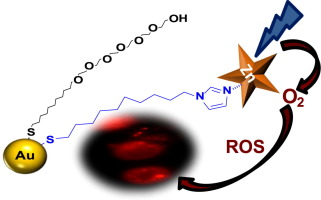Journal of Colloid and Interface Science ( IF 9.9 ) Pub Date : 2018-03-07 , DOI: 10.1016/j.jcis.2018.03.014 María E. Alea-Reyes , Oriol Penon , Paula García Calavia , María J. Marín , David A. Russell , Lluïsa Pérez-García

|
Hypothesis
Metalloporphyrins are extensively investigated for their ability to form reactive oxygen species and as potent photosensitisers for use in photodynamic therapy. However, their hydrophobicity generally causes solubility issues concerning in vivo delivery due to lack of distribution and low clearance from the body. Immobilising porphyrins on carriers, such as gold nanoparticles (GNP), can overcome some of these drawbacks. The mode of assembling the porphyrins to the carrier influences the properties of the resulting drug delivery systems.
Experiments
We describe the synthesis and characterisation of new porphyrin decorated water soluble GNP and we explore Zn-imidazole axial coordination as the mode of linking the porphyrin to the metallic core of the nanoparticles. Quantification of singlet oxygen production, toxicity in dark, cellular uptake by SK-BR-3 cells and phototoxicity have been assessed.
Findings
Axial coordination limits the number of porphyrins on the gold surface, reduces the formation of aggregates, and diminishes metal exchange in the porphyrin, all of which contribute to enhance the efficiency of singlet oxygen generation from the immobilised porphyrin. In vitro experiments on SK-BR-3 cells reveal a fast uptake followed by more than 80% cell death after irradiation with low doses of light.
中文翻译:

合成和体外多功能锌光毒性(II)的内消旋-四(4-羧基苯基)卟啉的涂覆的金纳米颗粒组装经由与咪唑配体轴向配
假设
对金属卟啉形成活性氧的能力进行了广泛研究,并用作光动力疗法中的有效光敏剂。然而,它们的疏水性通常由于缺乏分布和与人体的低清除而引起与体内递送有关的溶解性问题。将卟啉固定在载体上,例如金纳米颗粒(GNP),可以克服其中的一些缺点。卟啉与载体的组装方式影响所得药物递送系统的性质。
实验
我们描述了新型的卟啉修饰的水溶性GNP的合成和表征,并探索了Zn-咪唑的轴向配位作为将卟啉与纳米颗粒的金属核连接的方式。已经评估了单线态氧产生,黑暗中的毒性,SK-BR-3细胞对细胞的吸收以及光毒性的定量。
发现
轴向配位限制了金表面上卟啉的数量,减少了聚集体的形成,并减少了卟啉中的金属交换,所有这些都有助于提高固定化卟啉产生单重态氧的效率。在SK-BR-3细胞上进行的体外实验表明,在用低剂量的光照射后,其吸收迅速,随后细胞死亡超过80%。


























 京公网安备 11010802027423号
京公网安备 11010802027423号